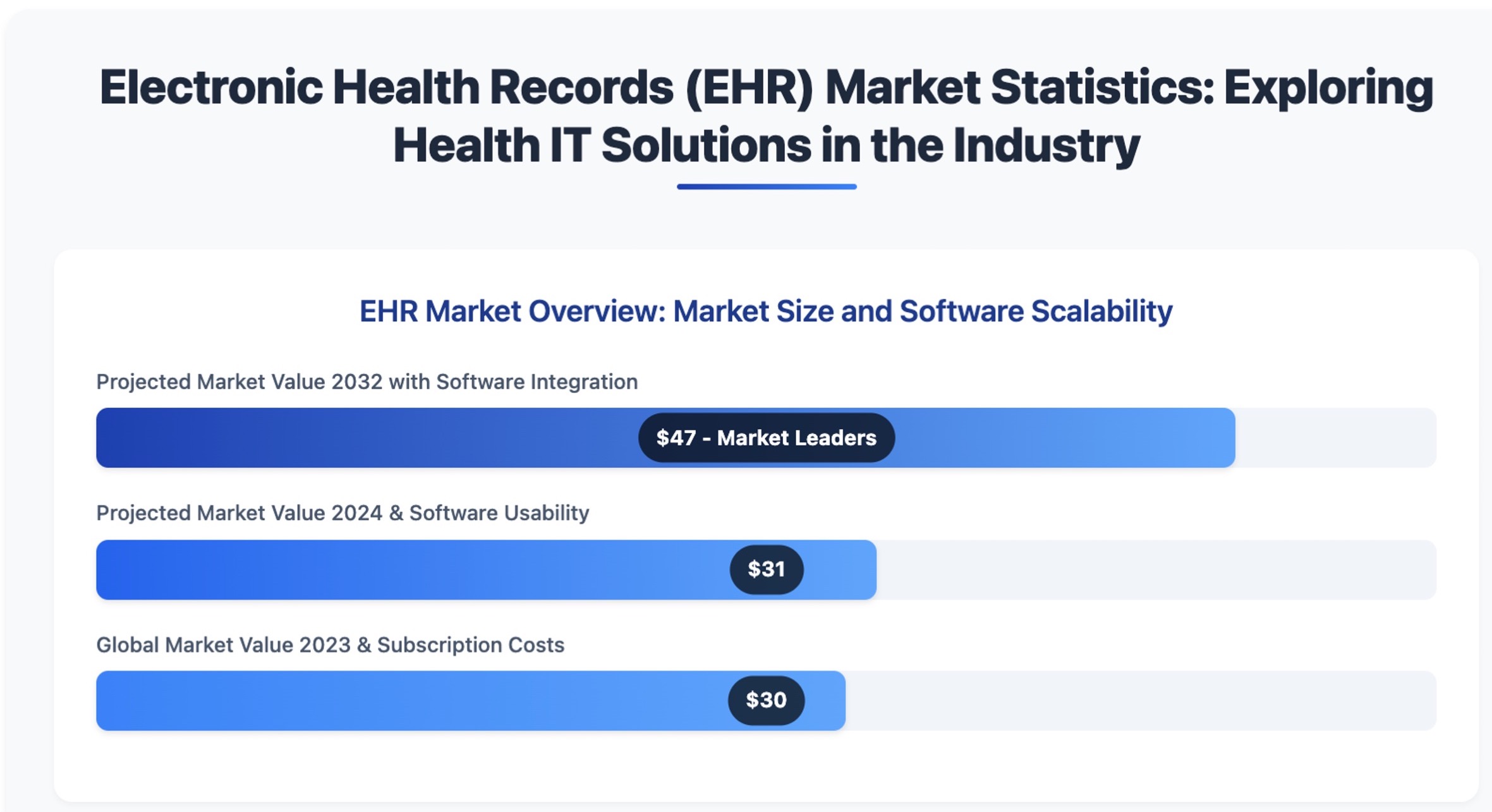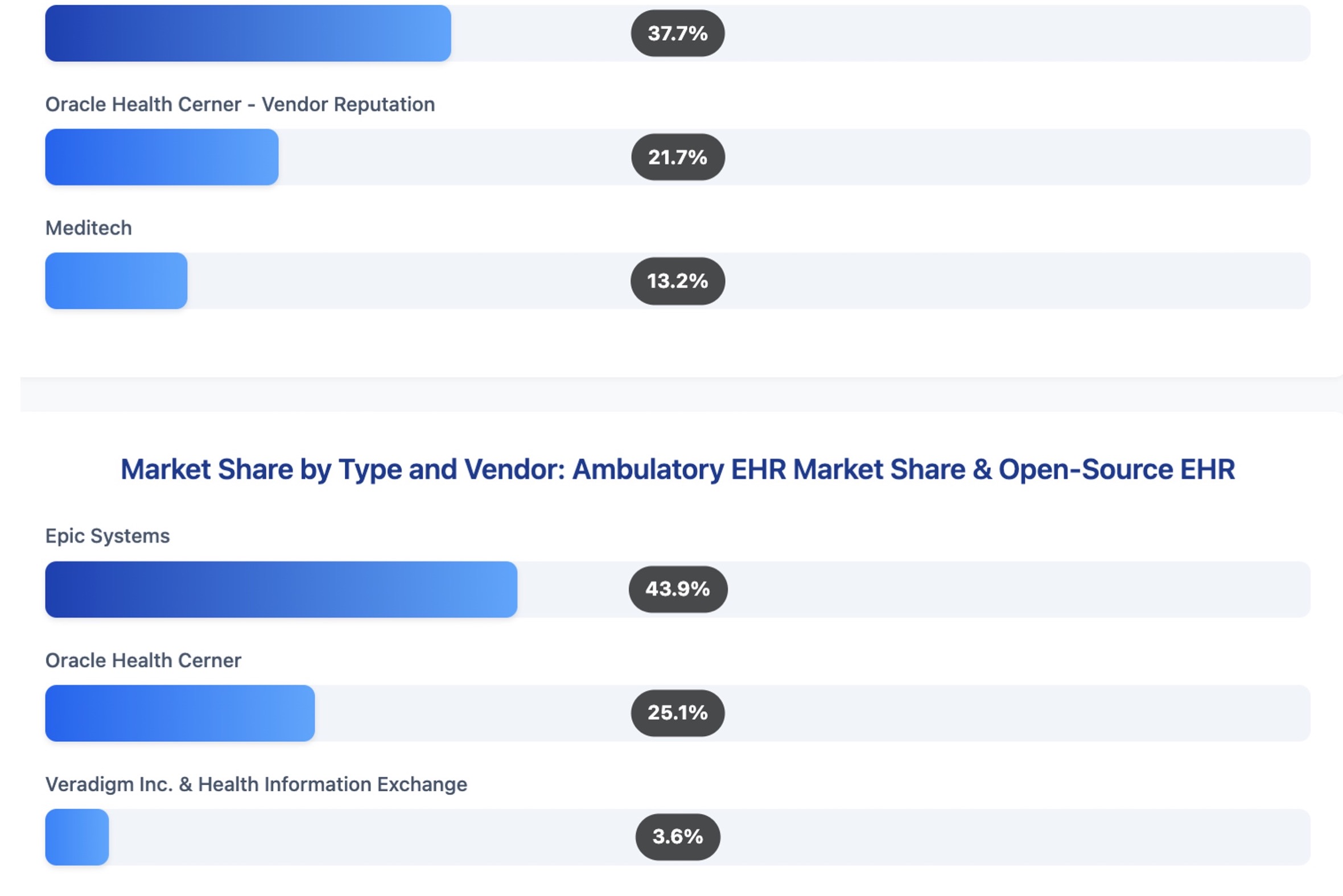Top 10 EHR Software | A Reviews of Features, Benefits, and Cost
In the current healthcare setting, medical professionals need to handle patient data quickly and effectively.
Electronic Health Record (EHR) software changes how healthcare providers operate by offering tools that simplify tasks, improve communication, and protect patient information. is changing how healthcare providers work, offering many features made to streamline processes, enhance communication, and safeguard patient data.
This article highlights the top 10 EHR software solutions, detailing their key features, benefits, and costs.
Whether you are a healthcare worker looking to make your practice better or someone curious about EHR systems, you will find helpful details to guide your choice. inform your decision.
1. Simplifies Patient Information Handling with system features

EHR software simplifies how healthcare providers handle patient information. It gathers electronic health records into one easy-to-access system, improving how healthcare providers, clinics, and hospitals work. This new healthcare technology enables healthcare providers to manage patients more easily by improving storage and access to medical records, enhancing user interaction with the system.
The system includes better user interfaces that help healthcare workers find key patient information quickly and increase user acceptance.
Custom dashboards and easy search features help you make fast choices when time is important.
Simple data sharing between different healthcare systems ensures that patient information is easily transferred between providers, allowing them to work together quickly and start treatments promptly. data interoperability.
For example, a primary healthcare doctor can quickly send important patient records to a specialist, ensuring the patient receives full care.
Digital records reduce the chances of mistakes associated with paper records. It also makes data more secure, helps patients get better care, and leads to smoother healthcare services.
2. Improves Efficiency and Productivity
EHR software increases efficiency and productivity in healthcare settings by taking care of routine tasks automatically, improving the organization of work processes, and enhancing practice management tools. This healthcare technology enables providers to focus more on patient care instead of administrative burdens, increasing operational productivity.
Key features include tools for scheduling that simplify booking patients and help decrease missed appointments, as well as billing software that simplifies managing claims and monitoring payments.
By creating a seamless experience, healthcare professionals can manage their time better while ensuring that patients receive the attention they need.
The success of these systems largely hinges on the level of training and ongoing support provided to staff. Without adequate instruction, even the most advanced software underperforms, leaving opportunities for improved usability untapped.
Making sure team members know how to use these tools is important for getting the most out of them, backed by end-user training resources. As mentioned, the integration of EHR systems plays a crucial role in aspects like modern medical billing, as explored in our analysis of The Role of Electronic Health Records in Modern Medical Billing.
3. Improves Communication and Teamwork
EHR software improves communication and teamwork in healthcare by making it easier to share patient details, which gets patients more involved in their care. The interoperability of EHR systems enables various healthcare providers to work together more effectively for better patient outcomes.
Integrated telehealth solutions within EHR platforms allow clinicians to connect remotely with patients, expanding access to care while maintaining continuity for those with chronic conditions.
Collaborative tools, like secure messaging and shared notes, enable medical professionals to communicate effectively and quickly address patient needs.
These systems often include methods for users to provide feedback, enabling healthcare teams to share their thoughts on the collaboration features. This feedback helps make ongoing improvements specific to their work tasks.
In the end, this method improves both team coordination and patient satisfaction because care becomes more responsive and matches personal health goals.
4. Increases Data Security and Privacy
EHR software greatly improves data security and privacy by following strict regulations such as HIPAA, which safeguards patient information from unauthorized access. With modern data storage methods and user access management, healthcare providers can improve how they handle patient data.
The software employs strong encryption methods to protect stored and transferred data, preventing unauthorized individuals from reading patient information.
Modern verification techniques, like using multiple forms of identification, make sure that only approved individuals can view important information.
Regular updates and steady software performance maintain strong security by addressing new threats and vulnerabilities.
Consistent improvements strengthen data protection, helping healthcare providers build trust with patients who depend on them to keep their personal information safe. For an extensive analysis of this trend, our comprehensive study on keeping up with healthcare regulations highlights the necessary steps that need to be taken.
5. Offers Customizable Templates for Different Specialties
EHR software provides customizable templates for various medical specialties, enabling healthcare providers to tailor their patient management workflows to specific needs and practices. This feature improves how well medical records are managed and how billing is handled.
These templates help pediatricians quickly note growth milestones and vaccination records. Surgeons can use surgical checklists to simplify pre-surgery evaluations.
Dermatology clinics use particular documents to perform skin check-ups and develop treatment plans, which lead to better results for patients.
Looking at features in different areas shows how flexible templates can improve ways to gather and report data.
These improvements make work processes smoother and more accurate in coding and billing, helping both healthcare providers and patients.
6. Provides Real-Time Access to Patient Records

EHR software provides immediate access to patient records, enabling healthcare providers to make quick and well-informed decisions. This skill is essential for effectively managing patients and raising the standard of care.
Fast access helps doctors find the right diagnosis and speed up treatment of health issues.
This capability enables healthcare professionals to collaborate effectively by sharing important information immediately.
Integrating mobile access and patient portals further amplifies this advantage, enabling patients to engage in their own healthcare by reviewing their records, appointments, and treatment plans.
Advanced data analysis tools regularly check patient health, helping providers notice patterns and potential problems early on. These tools help providers make early changes, leading to better patient results and happiness.
7. Facilitates E-Prescribing and Medication Management
EHR software simplifies electronic prescriptions and managing medications, increasing patient safety by reducing prescription mistakes and helping follow healthcare rules. This feature makes it easier to manage medications, making sure treatments are given on time and correctly.
Digitizing the prescription process reduces the risk of misinterpretation associated with handwritten notes. This method helps healthcare providers handle prescriptions and monitor patients’ medication histories more effectively.
Interoperability connects pharmacies directly with healthcare providers, enhancing communication.
This connection makes sure everyone can view the most recent patient information, allowing easy communication.
Patients benefit from improved care management and shorter waiting times, resulting in better health outcomes and higher satisfaction.
8. Integrates with Other Healthcare Systems
EHR software integrates seamlessly with other healthcare systems, improving interoperability and enhancing overall healthcare technology effectiveness. This system connection allows easy access to medical records and improves workflow across platforms.
For instance, laboratory information systems (LIS) integrate directly with EHRs, enabling providers to receive real-time lab results without searching through multiple systems. This integration lowers the chance of errors and speeds up the clinical decision process.
Similarly, connecting imaging software to an EHR enables physicians to review scans alongside patient records, leading to more informed diagnoses and treatments. These integrations support healthcare teams and significantly improve performance measures, resulting in higher patient satisfaction and better health outcomes.
9. Offers Reporting and Analytics Tools
EHR software provides strong reporting and analytics tools that deliver clear information on healthcare operations, which improves care quality and patient results. These tools examine information, allowing healthcare workers to assess performance and improve user satisfaction.
Customizable dashboards allow medical practices to generate detailed reports on various metrics such as patient demographics, treatment efficacy, and operational efficiency. This information helps spot patterns, such as times when patient visits peak or where staff underperform.
This information helps healthcare providers make better decisions, manage resources well, simplify healthcare tasks, and take steps to improve quality by analyzing data more effectively. By using these analytics, healthcare providers can create a setting that supports continuous learning, leading to better patient care and growth in their practice.
10. Reduces Paperwork and Storage Costs through Cost Efficiency
EHR software significantly reduces paperwork and storage costs by transitioning from traditional paper-based systems to efficient digital record keeping, which demonstrates the software’s cost efficiency. Digital tools help healthcare workers make better use of office space, keep tasks organized, and cut down on the use of big filing cabinets and too much paper storage.
This change creates a tidier workspace, enabling staff to concentrate on caring for patients instead of managing piles of paperwork.
In terms of long-term financial impact, adopting EHR software proves a worthy investment, as the upfront costs often yield substantial savings on materials, labor, and physical storage, showcasing its scalability and cost efficiency. This modern method improves daily operations and supports long-term practices that save money over time.
What Is EHR Software and How Does It Work with Healthcare IT Solutions?

EHR software, or electronic health record software, serves as a digital tool that manages patient information within healthcare systems, enabling healthcare providers to simplify patient management processes. It consolidates patient data in a secure environment while adhering to interoperability standards for seamless data exchange.
This advanced software improves how doctors handle clinical documentation and access information, aiding clinical decision support by providing immediate data access. Important features cover setting up appointments, handling prescriptions, and managing billing. These features help make operations more efficient.
Keeping detailed records of medical histories, lab results, and medication lists enables these systems to help providers offer individualized and organized care through effective patient data management. Enhancing inter-provider communication and reducing paperwork, the software significantly impacts healthcare technology, leading to better patient outcomes and increased satisfaction.
What Are the Key Features of EHR Software?
EHR software includes important features for managing patients, such as detailed reporting options, mobile access, and healthcare analytics tools that facilitate informed decisions based on data. Healthcare providers can adjust software settings to suit their specific needs, make their work process smoother, and work more effectively. Telehealth integration facilitates remote consultations and monitoring, which has gained importance in modern healthcare.
Patient engagement through portals provides people easy access to their health records, enables them to book appointments, and allows them to communicate with their healthcare providers. Together, these software features improve communication between different systems and increase user satisfaction, ensuring both providers and patients experience a smooth healthcare process, enhancing user experience. For those curious about optimizing billing processes alongside EHR integrations, you might find value in our insights on reducing claim denials with smarter medical billing tools.
What Are the Benefits of Using EHR Software?
Using EHR software has many benefits, including improved healthcare outcomes, better compliance with regulations, and higher user satisfaction, all contributing to more effective healthcare services. A key benefit centralizes patient records, enabling healthcare workers to quickly view complete medical histories for improved clinical decision support.
For example, when a doctor quickly reviews a patient’s previous treatments and medications, the doctor prevents dangerous drug interactions and creates treatment plans specific to the patient.
These systems often send alerts for regular check-ups, boosting performance numbers, increasing vaccination and testing rates, and resulting in better health results.
EHR software makes it easier to handle tasks such as medical billing and scheduling appointments, making daily operations smoother, cutting down on waiting times, and making visits better for patients.
Software security is very important. This software needs to be reliable and safe, protecting patient information to build trust and satisfaction.
This builds confidence among healthcare providers and patients in their online interactions.
Electronic Health Records (EHR) Market Statistics and Market Trends

Market Share by Type and Vendor: Hospital EHR Market Share & Performance Reviews

The Electronic Health Records (EHR) Market Statistics describe the changes happening in digital health record management, showing major growth and competition among leading companies. Knowing these statistics helps to see market trends and the place of big vendors in the EHR industry, showing software details and ratings.
EHR Market Overview shows strong growth, with the worldwide market estimated at $29.68 billion in 2023. Analysts project an increase to $31.0 billion in 2024 and further expansion to $46.63 billion by 2032, signifying a strong compound annual growth rate (CAGR). This growth highlights how healthcare systems globally are using digital health tools more and more, such as cloud-based platforms, because there is a demand for efficient, connected, and easy-to-access patient care.
Market Share by Type and Vendor shows the rivalry among top EHR companies. In the hospital EHR market, Epic Systems commands a substantial 37.7% market share, demonstrating its dominance and widespread adoption in hospital settings. Oracle Health Cerner follows with a 21.7% share, and Meditech holds 13.2%, indicating a competitive environment where innovation and user-friendliness are key to maintaining market position, emphasizing software functionality and system integration.
- In the ambulatory EHR market, Epic Systems leads again with an impressive 43.92% share, reinforcing its leadership in both hospital and outpatient settings. Oracle Health Cerner captures a 25.06% share, highlighting its strong position, while Veradigm Inc. holds a 3.6% share, indicating opportunities for growth in specialized or niche segments.
The Electronic Health Records (EHR) Market Statistics reflect a significant shift towards digital healthcare solutions, with major players like Epic Systems and Oracle Health Cerner leading the charge. As the market expands, competition will probably increase, leading to new developments and improvements in EHR systems to address the changing needs of healthcare providers and patients globally.
What Factors Should Be Considered When Choosing EHR Software?
When choosing EHR software, look at the software, compare vendors, check how you can customize it, and understand pricing plans to find a system that fits the needs of a healthcare practice.
It’s important to check how a vendor manages customer and vendor support because fast assistance can significantly impact daily operations.
Training users plays a crucial role. It increases staff confidence and helps them use the system well right away, improving how work processes function and showing the advantages of EHR.
A thorough cost check is necessary. It helps practices understand total expenses, including hidden fees and necessary upgrades, through thorough cost analysis and consideration of various pricing models.
Establishing performance metrics helps gauge the software’s effectiveness over time, ensuring that the investment translates into better patient care and operational efficiency, and supports patient privacy and telemedicine features. For practices, understanding why EHR integration matters in medical billing software can further enhance these outcomes, especially in the context of modern billing systems.
What Is the Cost of EHR Software and How Can a Business Determine Their Budget?
The price of EHR software can differ greatly depending on subscription fees, features, and pricing plans. Healthcare businesses need to closely examine these expenses to plan their budget correctly.
These pricing options include plans where you pay a monthly or yearly fee to use the software, and plans where you make a single large payment to own it permanently, depending on how the system is set up and the software design.
Healthcare providers need to look at both the direct costs and extra expenses like maintenance and upgrades for these models. They should also consider solution providers that offer open-source EHR choices.
Knowing return on investment (ROI) is important; this means examining how the software impacts productivity, quality of patient care, and the total costs in healthcare, enhancing electronic charting and software tools usage.
By learning about these elements and using software tools and health IT solutions, healthcare businesses can make informed decisions to improve their financial investments.
What Are the Potential Drawbacks of Using EHR Software?
Although EHR software offers many benefits, users should consider potential downsides to keep in mind, like difficulties in starting to use the software, how complicated the setup can be, and the importance of proper training and support for successful use.
These issues usually arise because staff members fail to participate enough during the change, which leads to pushback or confusion, and emphasizes the need for technical support and effective vendor comparison.
As users engage with the new system, they might encounter technical problems or issues with how it works that can slow down their tasks. User feedback and data visualization help teams identify issues, enabling them to improve the software and make it work better.
Regular training and strong technical help make staff feel confident using the system. This leads to smoother integration and better satisfaction, especially with electronic prescribing and software updates.
Author: Mike Cynar
Mike Cynar brings buyers and sellers together by producing reviews and creating non biased webpages allowing users to share their experiences on various products and services. He and his staff write informative articles related to the medical field, legal, and other small business industries.
Leave a Reply